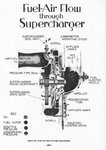kool kitty89
Senior Master Sergeant
A while back I discussed the different limitations and qualities of the single stage Merlin (ie 45) and Allison's supercharges. In doing so I saw how much smaller the Allisons supercharger casing apeared, fitted very crampped aganst the back of the engine.
I recently noticed the diameter given for the V-1710's impeller here http://www.raafwarbirds.org.au/targetvraaf/p40_archive/pdfs/1710-33.pdf
At 3.5 inches that would seem unusually small, especially compared to the "cropped" impeller of the low altitude version of the Merlin which was still 9.5" in diameter.
The supercharger seems to have remained the same on the Allison (excluding added auxiliary 2-stage version and turbocharging arrangements) except for the gear ratio. The early versions (with epicyclic reduction gearing) like the V-1710-33 of the P-40/B/C/Tomahawk had an 8.77:1 ratio (8.77x the engine speed) the newer -short nosed- versions (with stronger and simpler spur gearing) had an 8.8:1 rato like the -39,-73 of the P-40E/K (though this may just have been rounded, and the supercharger performance was similar). Additionally there were the 9.6:1 versions like the -81/99 of the P-40N and P-51A which had significantly beter altitude performance. (at the expence of greater charger heating)
The 3.5" figure would seem unusually small, could it be a mistake? (though judging by the engine's dementions and the size of the impeller casing, particularly compared to that of the single stange Merlin's, it would apear to be pretty small)


I recently noticed the diameter given for the V-1710's impeller here http://www.raafwarbirds.org.au/targetvraaf/p40_archive/pdfs/1710-33.pdf
At 3.5 inches that would seem unusually small, especially compared to the "cropped" impeller of the low altitude version of the Merlin which was still 9.5" in diameter.
The supercharger seems to have remained the same on the Allison (excluding added auxiliary 2-stage version and turbocharging arrangements) except for the gear ratio. The early versions (with epicyclic reduction gearing) like the V-1710-33 of the P-40/B/C/Tomahawk had an 8.77:1 ratio (8.77x the engine speed) the newer -short nosed- versions (with stronger and simpler spur gearing) had an 8.8:1 rato like the -39,-73 of the P-40E/K (though this may just have been rounded, and the supercharger performance was similar). Additionally there were the 9.6:1 versions like the -81/99 of the P-40N and P-51A which had significantly beter altitude performance. (at the expence of greater charger heating)
The 3.5" figure would seem unusually small, could it be a mistake? (though judging by the engine's dementions and the size of the impeller casing, particularly compared to that of the single stange Merlin's, it would apear to be pretty small)

